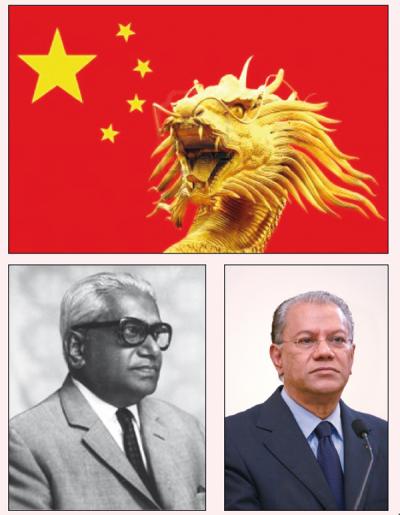As part of his “mo papa” propaganda, Dr Navin Ramgoolam often talks about the establishment of diplomatic relations between Mauritius and the People’s Republic of China (PRC) in 1972 as being a brilliant achievement by SSR that is unique in the history of international relations. He also affirms that all the help that Mauritius receives from China is the fruit of that action of SSR, and even said that “se ki mo dimande ar la Chine, mo pou gagne” in a speech tohonourhis father on 18 September 2013. However, it is our view that, in 1972, SSR was only following a trend set by other countries and, presently, PRC leaders are exploiting the credulity of Dr Navin Ramgoolam to the detriment of Mauritius and the advantage of their own country.
The Imbroglio of Two Chinas – The PRC and the Republic of China (ROC)
Opening up of diplomatic relations with the PRC was a “casse-tête” for many countries because of the existence of another China called the Republic of China (ROC). In the second half of the 1940s, the Nationalist Party was ruling China then known as the ROC, and, at the inception of the United Nations (UN) in 1945, the ROC became one of the five permanent members of the UN’s Security Council. Following a civil war, the Communist Party, led by Mao Tse Tung, defeated the Nationalist Party, seized control of mainland China, and proclaimed the establishment of the PRC on 1st October 1949. The Nationalist Party led Government of the ROC retreated to the nearby island of Taiwan. Both the PRC and the ROC claimed to be the sole legitimate representative of the Chinese people with the ROC keeping the permanent seat attributed to China in the UN’s Security Council.
The United States (US) decided to maintain diplomatic relations with the ROC, and actively helped the country to retain its privileged position at the UN because the PRC was communist; an ideology loathed by the US. Furthermore, the PRC received the recognition and support of another communist country, the Soviet Union which was then the archenemy of the US in what was known as the Cold War. The US pressured other countries to adopt its policy on China in pursuance of the fight against communism. However, Tanzania, a former British colony like Mauritius, recognised the PRC immediately after attaining independence in 1961. Uganda, Kenya, and Zambia; other former British colonies; emulated the move of Tanzania in 1962, 1963 and 1964 respectively.
Mauritius did not recognise the PRC when it attained independence in 1968, but did so four years later after significant shifts in policy on China by the UN, the US and the UK. On October 25, 1971, the UN General assembly voted a resolution to withdraw the recognition of the ROC and recognise the PRC as the only legitimate representative of China to the United Nations. The resolution was supported by 76 countries with 35 countries opposing and 17 countries (including Mauritius) abstaining. In a historic move to improve his country’s relations with the PRC, President Richard Nixon of the US visited the PRC’s capital, Peking, in February 1972. On 13 March 1972, the UK and the PRC established diplomatic relations. SSR’s Government in Mauritius followed the example of the UK on 15 April 1972. Mauritius under SSR was just following the crowd, indeed a late follower, when it established relations with the PRC.
Like Father Like Son – Both SSR and Dr Navin Ramgoolam Succumb to Flattery
Yet, in spite of the foregoing, Dr Navin Ramgoolam has on various occasions stated that, during his visits to the PRC in 1997 and 2007, Chinese leaders in Peking displayed extreme gratefulness to SSR for the latter’s decision to recognise the PRC, and often repeated that China never forgets its friends. Dr Navin Ramgoolam was and is still deeply moved by what he felt and heard during the visits, but he should have remembered a lesson taught by General Charles de Gaulle, President of France from 1959 to 1969, that “countries have no friends, only interests”. The nice words of Chinese leaders towards the father of Dr Navin Ramgoolam are designed to further their country’s interests, a solid example being the leasing of a sizable portion of land at Riche Terre to the Chinese Authorities for the setting up of the Jin Fei Project.
In his handling of Mauritius China relations, Dr Navin Ramgoolam exhibits a weakness inherent to SSR, susceptibility to flattery, which the British cunningly used to detach the Chagos from Mauritius. According to the book by Sydney Selvon entitled “A New Comprehensive History of Mauritius”, British Government officials prepared a three page comprehensive document to brief Harold Wilson, the Prime Minister of the UK, prior to his meeting with SSR on 23 September 1965 that decided the fate of the Chagos. The document advised Harold Wilson that SSR likes to be called “Sir Seewoosagur”, “Premier” or “Prime Minister’. The document also describes SSR as being a person who is “status conscious” and who “responds to flattery”.
The Chinese are beating Dr Navin Ramgoolam at his own game. At the local level, Dr Navin Ramgoolam uses many occasions to praise his father, even going to the extent of comparing SSR to Mahatma Gandhi and Nelson Mandela. Such a strategy solidifies his political base and renders him impervious to his opponents’ attacks in a significant portion of the electorate. At the international level, flattery of SSR by other countries fools Dr Navin Ramgoolam and, as a result, harms the interests of Mauritius.
SSR, Dr Navin Ramgoolam and China
- Publicité -
EN CONTINU ↻
- Publicité -

